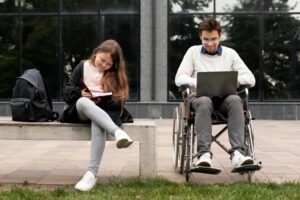Collaboration and communication between the school and the teacher
Materials
1. Introduction
Communication and collaboration between schools and teachers in a higher education institution (HEI) play a crucial role in creating an inclusive and productive environment, which promotes a sense of belonging and inclusivity among all staff members/teachers. Collaboration and communication are part of key soft skill competencies known as the “4Cs”: creativity, critical thinking, collaboration, and communication (Thornhill-Miller, 2023). Collaborative support between school and teachers is important to school success. Communication, openness, and participation are key for creating a climate of trust. Professional relationships based on trust contribute to the development of a common vision for the school (Martinez et al, 2021).
Effective communication and collaboration also improve productivity and promote a positive work culture that can lead to increased motivation and facilitate efficient coordination and implementation of schools’ goals. According to research in (Martinez et al, 2021), the school plays a major role in constructing conditions which promote knowledge sharing and collaboration, contributing to schools transformation and reorganization; suitable leadership emerges as a crucial factor of school improvement. The included research addressed the importance of creating opportunities for collaboration, highlighting the key role of leaders in building spaces and processes through which teachers can collaborate (Drossel, 2019).
2. Collaboration and communication between the school and the teacher
In today’s digital age, effective communication and collaboration are crucial for the success of educational institutions (HarrySub, 2023). Teacher collaboration pays off on students, teachers as well as the whole school level (Vangrieken, 2015). Establishing an appropriate collaborative and inclusive culture in HEIs is essential for creating a positive, productive, and supportive environment, increasing teachers motivation (Gabnytė and Strakšienė, 2019). The importance of such a culture extends to various aspects of the institution’s functioning and contributes to the overall success of the academic community. Several qualities support cooperation and communication at different levels between staff and management:
- Openness to Listening – building a collaborative relationship between schools and teachers, ensuring trust, engagement, and inclusivity, and creating an environment where both educators and administrators can work together to achieve shared educational goals. Emphasizing this aspect contributes to a positive school culture and enhances the overall educational experience for everyone involved.
- Continuous Learning – ensures that educators remain dynamic, engaged, and well-equipped to contribute meaningfully to the shared goals of educational institutions. The continuous learning and collaborative efforts create a positive and forward-thinking educational environment.
- Adaptability – empowering teachers and schools to be adaptable for collaboration to become more resilient, responsive, and effective in achieving shared objectives for student success and institutional excellence.
- Effective Communication Skills – ensuring clear and open lines of communication, where teachers feel supported, results in aligned goals and successful educational outcomes.
Crisis Communication – creating mechanisms for effective communication and information dissemination in uncertain times improve collaboration and communication activities in HEIs.
3. Types of communication
Communication in HEIs is mostly formal, however informal communication also contributes to success. While Formal Communication involves official channels such as meetings, reports, and official announcements, ensuring consistent and structured information flow, Informal Communication occurs through casual interactions, emails, and informal meetings. Both forms help build personal connections and a sense of belonging.
4. Good Practices of Communication and Cooperation
By emphasizing effective communication, fostering collaboration, and implementing good practices (James H. Stronge, 2018), HEIs can create a positive and inclusive atmosphere by following different good practices.
- Regular Meetings – scheduling regular staff meetings and forums to discuss HEIs matters encourages an open dialogue where staff can express concerns and provide input. Scheduling regular team meetings to facilitate open discussions, updates, and collaboration provides a platform for staff members to share their insights and experiences.
- Collaborative Projects – encouraging cross-functional or interdisciplinary projects that require collaboration among staff members. A sense of shared responsibility for common goals is attributed to good collaboration.
- Communication Platforms – implementing digital communication platforms to facilitate easy and efficient communication among staff members. Encourage the sharing of ideas, resources, and updates through these platforms.
- Transparent Communication – keeping staff informed about decisions, changes, and future plans, transparency builds trust and fosters a collaborative culture.
- Inclusive Decision-Making – involving staff in decision-making processes, especially those that impact their work. Inclusivity promotes a sense of ownership and commitment.
- Inclusive Policies – developing and implementing policies that promote inclusivity and diversity within the institution. Ensuring that all staff members feel valued and respected.
- Professional Development Opportunities – providing opportunities for staff to enhance their skills and knowledge. Investing in professional development shows a commitment to staff growth.
- Recognition and Appreciation – Acknowledging and appreciating the contributions of staff members. Recognition boosts morale and reinforces a positive work environment.
- Conflict Resolution Mechanisms – Establishing clear processes for addressing conflicts and concerns. Effective conflict resolution ensures a healthy work environment.
- Social Events – Organizing social events or team-building activities to strengthen interpersonal relationships. Informal settings can improve communication.
- Open-Door Policy – Implementing an open-door policy where staff members feel comfortable approaching management with ideas, concerns, or feedback. Fostering a culture of approachability.
Challenges in collaboration and communication activities and strategies how to overcome them
While promoting inclusive communication and participation in organizations, including schools and interactions with teachers, is generally beneficial, there can also be some challenges or negative impacts. Collaboration does not always result in school improvement (Martinez et. al, 2019). For collaboration to be effective, teachers must share pedagogical values and ideologies. From this, they can build solid interdependent relationships which drive organizational change towards more collaborative structures and result in school improvement. It’s important to be aware of potential drawbacks and address them to ensure that the efforts toward inclusivity are as effective as possible. Possible negative consequences of teacher collaboration on different levels (Vangrieken, 2015):
- Teachers level:
- Competitiveness, Interpersonal conflict, Loss of autonomy and Work intensification (Johnson, 2003)
- Time-consuming and creates tensions among colleagues (Bovbjerg, 2006)
- Teachers level:
- School’s level:
- Collaboration as a means for enforcing conformity of practice and monitoring the professionalism of the individual teachers (Main & Bryer, 2005)
- Collaboration as a servant of centralized control (discipline teachers and constrain autonomy) (Watson, 2005)
- School’s level:
Some general negative impacts include:
- Resistance to Change
- Some individuals, including teachers or school staff, may resist changes in communication methods or increased participation requirements.
- Resistance could stem from fear of the unknown, lack of familiarity with new technologies, or concerns about added workload.
- Resistance to Change
- Communication Overload
- Too much communication, especially if not well organized, can lead to information overload.
- Teachers may feel overwhelmed, leading to decreased engagement and responsiveness.
- Communication Overload
- Increased Workload
- Teachers may perceive inclusive communication and participation as additional tasks, leading to an increased workload.
- Without proper support or acknowledgement, this could lead to burnout.
- Increased Workload
- Unequal Participation
- Some individuals may hesitate to participate due to differences in personalities, communication styles, or cultural backgrounds.
- Inclusivity efforts may inadvertently highlight existing inequalities.
- Unequal Participation
- Digital Divide
- Reliance on digital communication methods may exclude individuals with limited access to technology or those uncomfortable with digital platforms.
- This can create a divide between tech-savvy and less tech-savvy individuals.
- Digital Divide
- Privacy Concerns
- Teachers and staff may have privacy concerns, especially when sharing personal experiences or feedback.
- This may lead to reluctance to participate in open discussions.
- Privacy Concerns
To address these potential negative impacts, organizations can implement different strategies. By acknowledging potential challenges and proactively addressing them, organizations can create a more inclusive and effective communication environment:
- Providing Adequate Training – training and support to help individuals adapt to new communication methods
- Clarifying Expectations – explaining the purposes and benefits of inclusive communication, addressing concerns about increased workload or privacy.
- Ensuring Diversity and Inclusion Training – fostering a culture of understanding and respecting diverse perspectives.
- Offering Flexibility – providing flexible options for participation, recognizing that individuals have different preferences and comfort levels.
- Regularly Assessing and Adjusting – Continuously evaluating the effectiveness of communication strategies and adjusting based on feedback.
5. How to establish an appropriate collaborative and inclusive culture in a higher education institution
Establishing an appropriate collaborative and inclusive culture in HEIs is essential for fostering a positive, productive, and supportive environment (Wright et al, 2022). There are several strategies to facilitate teacher collaboration, but different organizational models do not guarantee collaboration (Caskey and Carpenter, 2014). There are however different activities, presented in the following subsections, which can support a collaborative environment (Jongbloed et al, 2018).
- Recognizing, that people have different perspectives
- Inclusivity brings together individuals with diverse backgrounds, experiences, and perspectives.
- A culture that values diversity enhances creativity, innovation, and critical thinking
- Students benefit from exposure to a variety of viewpoints and experiences.
- Collaboration among students and faculty members enriches the learning environment and prepares students for a globalized world.
- Acknowledging, that collaboration leads to greater wisdom.
- Encouraging collaboration as a way of collective problem-solving.
- A culture that fosters collaboration enables the pooling of expertise, leading to more effective solutions to complex challenges
- Collaboration enhances communication across departments, administration, and among students.
- Effective communication is vital for the smooth operation of the institution and the successful implementation of academic initiatives.
- Fostering and inclusive environment
- An inclusive culture promotes a sense of belonging and engagement among all members of the academic community.
- Inclusive environments support faculty development and satisfaction.
- Faculty members feel valued and supported, leading to higher morale and commitment to the institution
6. Conclusion
In conclusion, effective communication and collaboration within HEIs are foundational elements for creating inclusive, productive, and supportive environments. It includes different stakeholders, including faculty, administrators, students, and staff, working together to achieve common goals. The establishment of an appropriate collaborative and inclusive culture in HEIs is important for success. Key qualities, such as openness to listening, continuous learning, adaptability, effective communication skills, and crisis communication mechanisms, play crucial roles in creating a positive relationship between schools and teachers. These qualities contribute to a positive school culture, enhance the overall educational experience, and help at achieving educational goals.
Good practices of communication and cooperation, including regular meetings, collaborative projects, communication platforms, transparent communication, inclusive decision-making, and professional development opportunities, contribute to creating a positive and inclusive atmosphere in HEIs. These practices enhance engagement, recognition, and conflict resolution, fostering a collaborative culture.
While the benefits of inclusive communication and collaboration are substantial, challenges may arise, such as resistance to change, communication overload, increased workload, unequal participation, digital divide, and privacy concerns. Strategies to overcome these challenges include providing adequate training, clarifying expectations, ensuring diversity and inclusion training, offering flexibility, and regularly assessing and adjusting communication strategies.
Targeted Audience
School management.
The teachers
Requirements
Key requirements for establishing good collaboration and communication between schools and teachers require Clear Communication Channels and Transparent Communication.
References
Books
- Miranda Jefferson, Michael Anderson, Transforming Schools Creativity, Critical Reflection, Communication, Collaboration, Bloomsbury Academic, 2017, ISBN 9781474232616.
- James H. Stronge, Qualities of effective teachers, 2018
- Jongbloed, B., Kaiser, F., van Vught, F., & Westerheijden, D. F. (2018). Performance Agreements in Higher Education: A New Approach to Higher Education Funding. In European Higher Education Area: The Impact of Past and Future Policies. https://doi.org/10.1007/978-3-319-77407-7_40
Articles and Research Papers:
- García-Martínez, I., Montenegro-Rueda, M., Molina-Fernández, E., & Fernández-Batanero, J. M. (2021). Mapping teacher collaboration for school success. School Effectiveness and School Improvement, 32(4), 631–649. https://doi.org/10.1080/09243453.2021.1925700
- Vangrieken, K., Dochy, F., Raes, E., & Kyndt, E. (2015). Teacher collaboration: A systematic review. Educational Research Review, 15, 17–40. https://doi.org/10.1016/j.edurev.2015.04.002
- Gabnytė, G., & Strakšienė, D. (2019). The role of communication and collaboration influencing teachers’ professional motivation. Social Welfare : Interdisciplinary Approach, 9(2), 67–77. https://doi.org/10.21277/sw.v2i9.474
- Thornhill-Miller, B., Camarda, A., Mercier, M., Burkhardt, J.-M., Morisseau, T., Bourgeois-Bougrine, S., … Lubart, T. (2023). Creativity, Critical Thinking, Communication, and Collaboration: Assessment, Certification, and Promotion of 21st Century Skills for the Future of Work and Education. Journal of Intelligence, 11(3), 54. https://doi.org/10.3390/jintelligence11030054
- B. Johnson, Teacher collaboration: Good for some, not so good for others, Educational Studies, 29 (2003), pp. 337-350, 10.1080/0305569032000159651
- K.M. Bovbjerg, Teams and collegiality in educational culture, European Educational Research Journal, 5 (2006), pp. 244-253, 10.2304/eerj.2006.5.3.244
- K. Main, F. Bryer, What does a ‘good’ teaching team look like in a middle school classroom? In B. Bartlett, F. Bryer, & D. Roebouck (Eds.), Stimulating the “action” as participants in participatory research: Proceedings of the 3rd International Conference on Cognition, Language, and Special Education, http://www98.griffith.edu.au/dspace/handle/10072/2538
- Forte, A. M., & Flores, M. A. (2012). Potenciar o desenvolvimento profissional e a colaboração docente na escola [Enhancing teacher professional development and collaboration at school]. Cadernos de Pesquisa, 42(147), 900–919. https://doi.org/https://doi.org/10.1590/S0100-15742012000300014
- Wright, C., Ritter, L. J., & Wisse Gonzales, C. (2022). Cultivating a Collaborative Culture for Ensuring Sustainable Development Goals in Higher Education: An Integrative Case Study. Sustainability, 14(3), 1273. https://doi.org/10.3390/su14031273
Online Resources:
- Harrysub, Enhancing Communication and Collaboration with a School Management System, Medium, 2023 (link: https://medium.com/@harrysub98/enhancing-communication-and-collaboration-with-a-school-management-system-617bf5b00d94)
- Micki M. Caskey, Jan Carpenter, Building Teacher Collaboration School-wide, 2014, https://www.amle.org/building-teacher-collaboration-school-wide/
- S.T. Watson, Teacher collaboration and school reform: Distributing leadership through the use of professional learning teams, Doctoral dissertation). University of Toronto, http://citeseerx.ist.psu.edu/viewdoc/download?doi=10.1.1.91.8080&rep=rep1&type=pdf (2005)
1. Leadership/ School’s perspective
Inclusive Digital Strategy and Policy for Empowering Inclusive Digital Education
…..
15 min
After completing this unit, the learner will be able to:
- Explain what inclusive digital education strategy is and its importance in enabling inclusive digital education.
- Describe the essential parts of the inclusive digital education strategy.
- Create an inclusive digital education strategy.
Strategy, Education Strategy, Inclusive Digital Education, Inclusive Strategy, Inclusive Strategy Structure








Funded by the European Union. Views and opinions expressed are however those of the author(s) only and do not necessarily reflect those of the European Union or the European Education and Culture Executive Agency (EACEA). Neither the European Union nor EACEA can be held responsible for them (2022- 1 -SI01 -KA220-HED-000088368).






